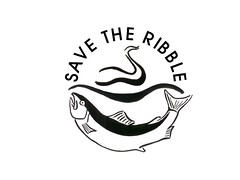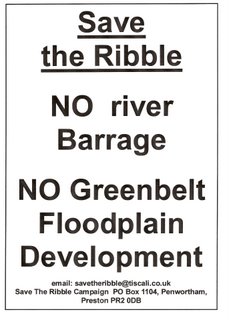Ribble Coast & Wetlands
The Ribble is one of the most important places in Europe for wildlife… its designation as a Regional Park - the Ribble Coast & Wetlands, officially launched on Friday 23rd March 2007 - is a positive and exciting step forwards in showing how protecting the Ribble’s inter-tidal ecosystem, for now and for future generations, will also boost the local economy.

Ribble saltmarsh at Marshside near Southport.
As a Regional Park, offering greater access to the Ribble’s dynamic and irreplaceable habitats, the Ribble will boost income from eco-friendly tourism opportunities by £115 million or more every year…
... and that’s just the new visitors who will be attracted to the Ribble's numerous current attractions, including Marshside Nature Reserve, Ainsdale and Birkdale Sandhills, the Ribble Discovery Centre, and Lytham Nature Reserve, not to mention new reserves in the near future such as Hesketh Out Marsh, the Tarleton to Hesketh Bank Linear Park, and the Sefton Natural Coast, and extensions and improvements to Martin Mere, Longton and Hutton Marshes, and Rufford Old Hall wetlands…
These are just a selection of the existing and newly-proposed eco-tourism opportunities which will form great attractions for the Ribble Coast & Wetlands Regional Park.
Yes, we can put the Ribble at the centre of our thinking without damaging its environmental integrity, or destroying its character, or denying its unique place in local, national, and international terms!
You can read what the World Wildlife Fund says about the economic importance of wetlands.
The Ribble Coast & Wetlands Regional Park will boost eco-tourism opportunities ALL YEAR ROUND as some of the best wild-life watching takes place outside of the traditional holiday season!
The new proposals for the Ribble Coast & Wetlands (RCW) also include fantastic new access routes for walking, cycling, and horse-riding, which will all become part of an intricate, accessible and dynamic North West Coastal Trail…

North West Coastal Path, Freckleton Pool.
…such as the Lancashire Coastal Way (some of which is already open), North West Coastal Path and the Sefton Coastal Path (again, some already completed), the Regional Coastal Trail, a foot/cycle/bridle bridge over the River Douglas, the Burscough to Banks Wetland Walk, the RCW Regional Park Cycleway, the Fylde Coast Cycleway, Lancashire Cycleway, the Trans Pennine Trail, and the Preston Guild Wheel (which will also link in to several other walking and cycling routes), all linking in with the Ribble Way, the Douglas Way, existing footpath networks, and the Southport to Preston National cycling route…
With the huge new Wetland Nature Reserve at Brockholes now in the pipeline – thanks largely to local people helping the Wildlife Trust save this fantastic wetland resource from building developments! – Preston itself also has a lot to offer the Ribble Coast & Wetlands Regional Park…

Brockholes Wetland, a Reserve in the making...

The Ribble Green Belt and floodplain - and a fantastic cycleway - between Fishwick Bottoms and Brockholes.

…and if the redevelopments of Preston Docks and Avenham & Miller Parks are undertaken in a sensitive and eco-friendly manner, these will be just some of the ways Preston can contribute positive and environmentally-sensitive attractions to the Ribble Coast & Wetlands network...
Reinstating the canal links in Preston itself, along with improvements to the Docks, are two ways in which the Riverworks scheme can make positive rather than negative contributions to the Regional Park, based as it is on preserving and enhancing the Ribble’s dynamic and Internationally-significant wetland ecosystem…
- but the other Riverworks proposals of barraging the Ribble and building massive housing and business developments on its floodplain and Green Belt areas clearly contravene the whole Regional Park raison d’etre as both of these proposals would interfere with the Ribble’s irreplaceable inter-tidal ecosystem on the one hand, and reduce its green infrastructure on the other.
The damage the barrage alone would cause to the Ribble’s inter-tidal ecosystem, by interfering with the natural free-flows of silts and nutrients, fresh and salt waters, which form the life-blood of this wildlife ecosystem, has been extensively covered on this blog, and is evidenced in the huge damage caused by similar schemes around the world, such as the Glen Canyon Dam on the Colorado River in the Grand Canyon, where:
‘Ninety-five percent of Grand Canyon's sediment and nutrients are trapped behind Glen Canyon Dam. Organic materials mixed into this sediment used to provide the fertilizer for the river ecosystem's health. Instead, the Colorado River in Grand Canyon now runs clear and cold, allowing the green alga cladophora to grow and replace the natural warm-water food web. The absence of replenishing sediment is also causing critical beach and sandbar habitat to disappear, and undermining the stability of archaeological sites…’

The Ribble's silts - the life-blood if its wetland ecosystem - clearly visible at low tide washing downstream between Penwortham and Preston.

The confluence of the Douglas into the Ribble, and the silt-rich mudflats exposed at low tide.

Rich inter-tidal Ribble mud.
The WWF point out that:
'wetlands are economically valuable biomes that provide goods and services upon which many communities and economies depend. Recognizing the economic importance of wetlands in addition to their biodiversity, scientific value, climate regulation, potential tourism, socio-cultural and other important wetland values is yet another good reason to reverse global wetland loss...
Dams disconnect rivers from their floodplains and wetlands. The damage to freshwater ecosystems can be devastating. They impact on the migratory patterns of fish, and flood riparian habitats, such as waterfalls, rapids, riverbanks and wetlands.
By slowing the movement of water, dams prevent the natural downstream movement of sediment to deltas, estuaries, flooded forests, wetlands, and inland seas, affecting species composition and productivity.
Dam operations also influence water quality. Water and sediment retention affect water quality and the waste processing capacity of rivers (the ability to break down organic pollutants). This could lead to production of toxic hydrogen sulphide gas that further degrades water quality.'
This is why it is so important that we do not endanger the Ribble's ecosystem by allowing any kind of dam, barrage, weir or barrier to be built, merely for the sake of a 'Water Sports Park'.
As it is, Preston Docks and Marina already bring much boating and sailing traffic through the Ribble Link, connecting Lancaster Canal to the inland waterway network south of the River Ribble – and all without the necessity of a barrage.
So boating folk have to wait for the tide, as they have done for centuries… but this is part of what boating is all about, an intricate relationship with the tides, weather and moods of the river and the sea, and it is clearly not worth the enormous risk to the Ribble’s delicate and irreplaceable inter-tidal ecosystem to interfere with its natural inter-tidal behaviour just so that boats can pass through without having to wait for the tides…

Just some of the traffic at Freckleton Pool

Freckleton Naze just downstream of where the Pool meets the Ribble.
If the perpetual blue-green algal blooms in the Dock basin can finally be solved (as much work done by the Environment Agency and partners bring the hope that it might be in the future), then the Docks could be utilised far more than just providing an idle mooring-space for boats and a back-drop to the weekly shopping as they do at present…
At the launch of the Ribble Coast & Wetlands, Laurence Rose, Regional Director of the RSPB, said that designating the Ribble a Regional Park enables long-term thinking to protect the most important single river estuary in Britain – which supports in the region of 1 million birds all year round - at the same time as promoting coastal tourism throughout the year which will bring in an extra £115 million to the local economy from new visitors.
So, the Internationally-significant numbers of bird species the Ribble supports every winter – 16 species in Internationally-important numbers - between 250,000 and 350,000 birds (including 70,000 Wigeon, 36,000 Dunlin, 34,000 Knot, 30,000 Pink-Footed Geese, to name but a few…) is more than the combined human population of Preston and South Ribble…
All year round, the Ribble supports more birds than the combined human populations of Preston, South Ribble, the Fylde, West Lancashire, Blackpool, Wyre, Chorley, the Ribble Valley… in fact, almost as many birds depend on the Ribble’s inter-tidal ecosystem as there are people in the whole of Lancashire… and the human population of the North West as a whole also benefits from the quality of life the Ribble’s ecosystem brings on every level.

Ribble inter-tidal ecosystem supports wildlife and human communities.

Michael Jack, MP for the Fylde, gave a keynote speech at the launch of the Ribble Coast & Wetlands, in which he pointed out that seeing the river as a divide between communities shows a dangerous lack of understanding of the importance of the Ribble to the environment and to our communities.
He went on to say that only by understanding what a rich treasure-house the Ribble is in biodiversity terms can we ensure we say “YES” to developments which improve our access to the Ribble, and “NO” to others which will damage this unique environment.
Michael Jack has made it clear he is very concerned about the impacts of a barrage on the Ribble, and has been working hard to ensure that Environment Agency advice AGAINST building developments on the flood plain are adhered to by local councils and other developers…
The Ribble Coast & Wetlands Regional Park aims to protect and improve this unique and irreplaceable environment, and the quality of life for local communities. This will be by improving access and facilities for local people as well as create fantastic eco-tourism opportunities... and by protecting the Ribble’s wetland habitats, this will protect and enhance the quality of life – and flood protection – these also bring to local communities.

Long Live the Ribble Wild!

You can read more about the Ribble Coast & Wetlands Regional Park here and here.
You can contact us at savetheribble@tiscali.co.uk
Labels: biodiversity, ribble estuary, wetlands, wildlife















0 Comments:
Post a Comment
<< Home